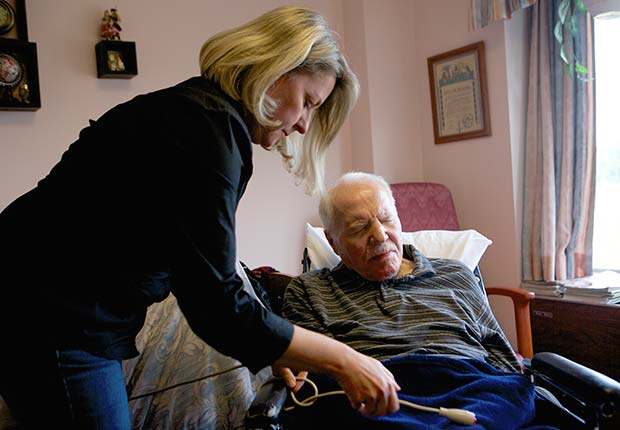AARP Hearing Center

By Ann Levin
Two years ago, Dorothy Procaccini’s father picked up a bacterial infection while hospitalized in Rochester.
Krzysztof Kotkowicz, 82, was discharged with orders to finish a course of antibiotics and schedule follow-up visits with a home health care agency. Over the next year, he was back in the hospital five or six times with a recurrence of the infection, C. difficile, known as C. diff, whose symptoms include nausea, fever and diarrhea.
When his problems began, Kotkowicz, who has a mild case of Parkinson’s disease, lived on his own and got around with a walker. By year’s end, he was so weak that Procaccini and her sister could no longer care for him at his home, and he moved into a nursing home.
The experience led Procaccini to become a strong supporter of the Caregiver Advise, Record, Enable (CARE) Act, a bill to support caregivers that was introduced in the state Legislature last session.
It would require hospitals to notify and offer to meet with a patient’s caregiver to discuss post-discharge care plans and train the caregiver, if requested, on performing basic nursing tasks at home such as injections and wound care. About 90 percent of New York voters age 50 and older support the proposal, according to an AARP survey released in September.
Procaccini, 49, lives with her husband and three children in suburban Rochester and works as a freelance project manager for marketing firms. She wishes she had been told how to cleanse C. diff spores from contaminated areas, for example, and that patients with such infections often need to stay on antibiotics longer.
“We were never really taught what we could do to keep this at bay,” she said. “It would have been helpful to be trained rather than have to rely on a home health care agency. If I need to take on 90 percent of the responsibility, then I need to know that at the time of discharge.”
The CARE Act, enacted by two states—New Jersey and Oklahoma—and introduced in several others, is at the top of AARP New York’s agenda when the Legislature returns Jan. 7. “It is clear to AARP that we need to incorporate family members into our hospital discharge process,” said Bill Ferris, AARP New York state legislative representative.
4.1 million provide care
A memo attached to the CARE Act legislation notes that 4.1 million New Yorkers provide some form of unpaid care to loved ones—care worth an estimated $32 billion a year.
Yet they are not routinely included in discussions about the patient’s care and receive little or no training in how to perform follow-up medical tasks at home.
The Greater New York Hospital Association has not yet taken a position on the CARE Act.
AARP New York will also push for another $20 million in next year’s budget for home- and community-based services, such as Meals on Wheels and visits from home health aides, that have waiting lists. The State Office for the Aging manages these services with a current budget of $237 million.
Laura Cameron, executive director of the Association on Aging in New York, a nonprofit that represents the state’s 59 county-based associations for the aging, said county directors told her the wait for services can be well over a year.
The Chautauqua County Office for the Aging reported that from 2010 to 2014, older adults in the county waited an average of 457 days for services. The average age of clients on the list was 82.
AARP New York also strongly supports a bill to create an independent consumer advocate to represent residential customers when utilities seek rate increases in the state. New York has the nation’s second-highest average residential electric rates, trailing only Hawaii.
The bill passed the General Assembly last session but stalled in the Senate. Eight in 10 voters 50 and older favor the idea, according to the September survey.
In addition, AARP New York wants to launch a public discussion about establishing a retirement savings program for the roughly 4 million New Yorkers without access to an employer-sponsored plan at work.
Modeled on popular college savings plans, the state-sponsored program would let workers, including the self-employed, set aside part of their wages in tax-deferred accounts.
Ann Levin is a writer living in New York City.































































